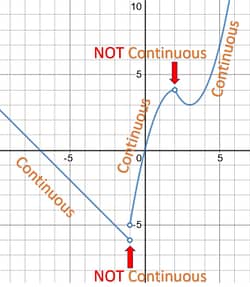Definition of Continuous Function
Once you have mastered applying a limit to an equation, calculus will then have you start applying that new tool to additional concepts. What this means is that the limit is no longer the final conclusion to a calculus problem. Instead, the limit is now a single step in a larger process.
The first place you will be asked to apply your new found limit skills is in determining the continuity of an equation.
Definition: Continuous Function
A function is continuous at a point c in its domain if
Note:
– This is the definition you will need to apply when you are asked to, “use the formal definition” to show a function is continuous at a given x-value .
– In more everyday language, a function is continuous at a specific x-value = c , when the limit value at that x-value, , equals the function value (y-value), , at that same x-value.
– I like to say, “Does the limit equal where I would put the dot on the graph at that x-value ?”
– When looking at this definition in terms of a graph, the places where you would have to lift your pencil to continue drawing the graph (holes, vertical asymptotes, jumps, breaks in the graph) are the places where the function is NOT continuous. These are the places where .

– Most parts of a function are usually continuous.
